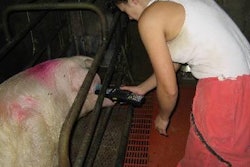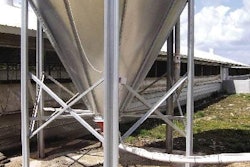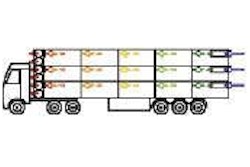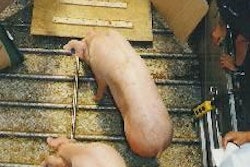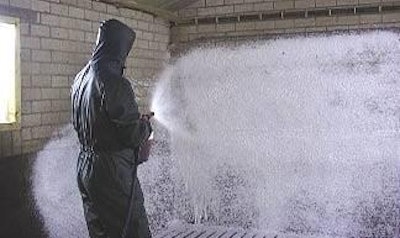
Too often, the people who clean pig pens think the job involves simply turning the pressure washer up to full power and throwing as much water as possible at all the surfaces. This attitude is plainly wrong, for several reasons. It wastes water, it takes too much time and even worse it fails to give good hygiene.
Today's ideal cleaning protocol starts with the preparation, which basically means moving out the portable equipment and scraping or sweeping the floor to remove loose dirt. Then there is the hose-down, but now it also includes the application of a detergent taking care to observe the correct contact time before the final stages of rinsing with water and allowing the pen to dry.
Experience with detergents has been growing fast over the years, motivated by a desire to save water and effective labour time wherever possible. Tests have confirmed how including a detergent can bring overall savings of 20% or more when compared with the use of water alone for cleaning a pen. However, the superior cleanliness obtained in comparison to cleaning with just water is even more important. It adds up to reduced contamination risks through fewer germs and less residue to interfere with the action of the sanitiser.
Future concepts will place more emphasis on the amount of time and detergent involved. Successful trials have been carried out already in which quite low pressures (20-40 bars) were combined with slightly higher water volumes.
The interest in possibly using a lower pressure has been triggered by some warnings of the potential effects of operating a washer at high pressure. For the point of view of the operator's health, it is of obvious concern if the pressurised jets turn the water into an aerosol of tiny drops capable of carrying dirt and germs into the lungs. Moreover, the aerosol can remain within the environment of the room for up to 3 hours after cleaning and in that period of time the air-borne particles of contamination may still present a risk.
There are ways to reduce this problem. They involve not just lowering pressures while attending to the detergent and its contact time. The design and choice of materials for the pens also have a part to play, for the simple reason that some surfaces are so much simpler to clean.
Better sanitation must start with a recognition that the efficacy of a sanitiser depends on the cleanliness of the surface. In fact, the expense and effort spent on disinfection may be wasted unless the dirt is removed first. Research also has shown how the quality of the detergent determines the success of removing micro-organisms. Clearly it pays to choose detergents that have a high added value and a cleaning power capable of bringing the greatest benefits.
Combination for cleaning
Fundamentally, the effectiveness of the clean-up depends on the detergent used, the amount of time it is in contact with the surface, the temperature at which this occurs and what is known as the mechanical effect in practice, the impact of jets of water from a pressure washer or the action of scrubbing. All these elements must be in place before a high standard of hygiene can be achieved. Any deficiency in one of them has to be compensated by adjustments to the others.
On pig units, the most likely shortfall is in operating temperature. The cleaning temperature is normally low. The usual response is to try to compensate by applying water at a high pressure, typically up to 150-200 bars. But a sophisticated detergent also can compensate for the low temperature. An increased wetting effect will be obtained from a longer contact time.
Remember additionally that the dilution of the detergent will limit its concentration and make the composition even more important. The composition necessary for a high-value detergent relates to the fouling in the pig house. The fact we are dealing with residues of feed, manure, water and animals means a requirement to remove fat, proteins, minerals and starch. Some basic components are therefore absolute requirements. Among these is the surfactant included to enable the detergent to remove fat. Without it, the cleaning water would not be able to penetrate the layer of fat left in the pen so the detergent was less effective.
Dispersants or emulsifiers are present in order to prevent dirt from precipitating again once it has been extracted into the cleaning solution. They guarantee that the dirt can be flushed away to the slurry pit and released only at an increased dilution. Complexing agents are also known as water softeners. They are added to stop the precipitation of minerals in the water that would otherwise disturb the cleaning effect by creating a shelter for micro-organisms. Some complexing agents also have been shown to help break down complex dirt structures, such as those found after liquid feeding. Overall, an alkaline detergent tends to be chosen wherever the clean-up must deal with organic material such as that found in a pig pen. The alkalinity is arranged in most cases by including either potassium hydroxide (KOH) or sodium hydroxide (NaOH) to support the cleaning strength.
Gaining profit from the use of a detergent requires a complete composition. It is false economy to try to save on the quality. Although representing only a small part of the total costs, a good detergent offers valuable advantages in terms of labour and water usage. Do not forget also that a used detergent goes down the drain, so its biodegradability is an environmental issue.
How to apply it for good cleaning? Today's technology offers several options. Traditional spraying has the downsides of poor visibility, aerosol formation and cost. Gel application gives a stable, foam-like presence that adheres strongly to the surface and ensures long contact times. By contrast, the contact time is relatively short when the detergent is applied as a foam. But the foam creates a layer of bubbles which collapse at the surface. As they form a thin film that runs down the surface, the dirt is stripped away continuously and brought in contact with new foam.
Clinging foam
A last option is long-cling foaming. This still-novel procedure has started to set new standards for applying a detergent, in situations for standard cleaning as well as in those requiring a long interaction between detergent and dirt. Combining the dynamics of foam with the longer contact times of a gel, it offers major benefits especially in the severely soiled conditions of a pig pen. Contact times of u p to 2 hours are within reach.
All these applications can be carried out using standard equipment that is widely available in most countries. Bearing in mind that applying a detergent should not occupy a great amount of working time, however, it is worth also checking the time-saving possibilities of the automated wetting/foaming systems that are currently making their introduction.


